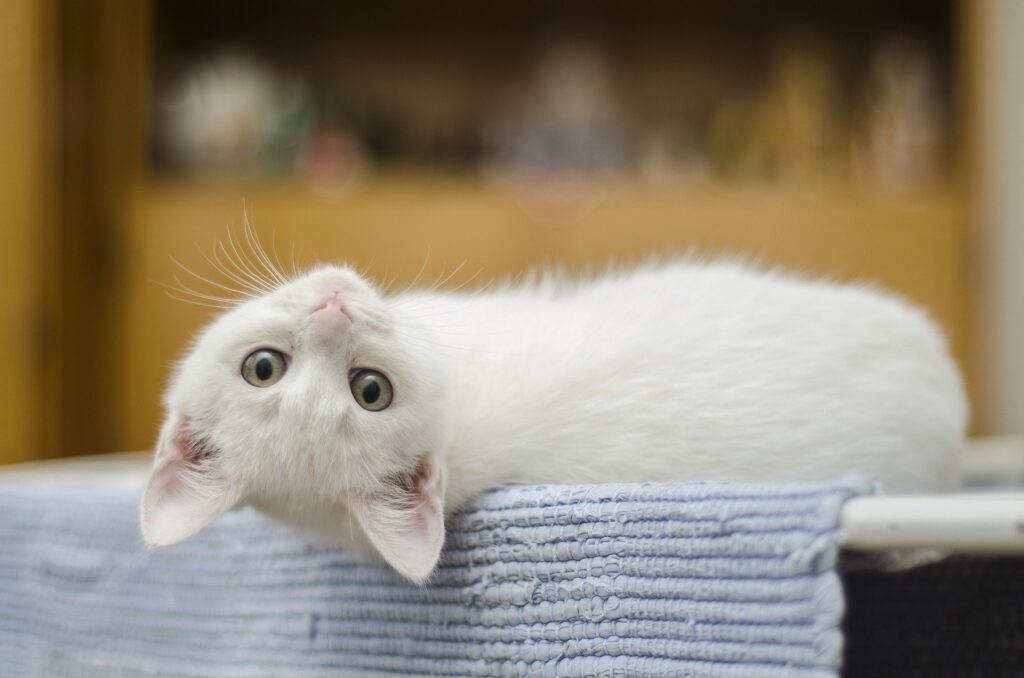How to litter train a kitten without a mother
As a new pet parent or a soon to be one, you are probably wondering how to litter train a kitten without a mother.
Cats instinctively do potty in sand or soil, and kittens learn from watching their mother.
Mother cats who are litter box trained generally teach their kittens how to use the litter box when they are around 3 to 4 weeks of age. So, kittens that are raised by their mother may already be litter box trained.
Stray or feral kittens will not know how to use a litter box though the mother would have taught them to do potty in the dirt and cover up with leaves.
If you have adopted a kitten raised indoors and which is around eight weeks – the right age to leave its mother – there is a high probability that your kitten is already litter box trained.
However, if you have adopted an orphaned kitten, you will have to train the kitten on the proper use of a litter box, and it may take a bit longer when you have to do the training in the place of a mother cat or another adult cat.
Cats doing potty outside the cat litter box is a major feline behavior problem and a leading cause for people to let go of their cats. Hence it is essential to teach your kitten the proper use of the litter box to avoid future problems.
Our top tips below on how to litter train a kitten without a mother will yield quick results if you follow it consistently.

Requirements of a newborn kitten
Newborn kittens will require your support to do potty in the absence of its mother cat.
Mother cats encourage kittens to pee and poop by licking their anal area, and a newborn kitten will require your help until she is around 2 to 3 weeks of age.
In the mother’s absence, you can stimulate the anal area by massaging with a small warm towel to encourage bowel movements.
In about three weeks, you can start litter box training for your kitten.
Patience

In our tips on how to litter train a kitten without a mother, patience is an absolute must. Training a kitten to use the litter box can be a bit messy, and its only with patience that you can achieve results.
Just remember to use positive reinforcement such as praise to encourage the kitten and never resort to punishment when the kitten has an accident outside the litter box.
Your kitten is young, and everything is new, and the training you provide in the early years will continue to be with her throughout her lifetime.
Patience, consistency, and gentleness will ensure your success with the training.
Limit the territory of your kitten
Don’t allow your new kitten to roam your entire house in the initial stage. It will help if you keep your kitten in a quiet place such as a spare room.
Limiting your kitten’s territory will ensure that if an accident happens while you are litter box training your kitten, it will be only in the room and not in a corner that is difficult to clean.
Just make sure that the quiet area has everything the kitten needs – bedding, food, water, toys, and a clean litter box.
Put your kitten in the litter box
Once your kitten is comfortable in her new space, you can start the training by placing the kitten in the litter box. Follow the below steps for best results:
- Put the kitten into the litter box after playing, feeding, or when she wakes up from a nap.
- Stir the litter to create interest.
- Allow the kitten to hop in and out of the litter box, and don’t stop her. As kittens are curious by nature, you should expect them to play, dig and sniff in the litter and there will be a bit of mess in the early days.
- If the kitten is still unable to associate the litter box with the need to use the bathroom, put some stool in the litter box to speed up the process.
- You can also use a litter with pellets to cover the feeling of wetness.
- When your kitten is successful in using the litter box, remember to be generous with your praise to help your kitten associate the use of the litter box with a positive experience.
Choose the right litter
It’s best to be cautious when your kitten is in the litterbox as they may eat litter or swallow bits stuck to their paws while grooming.
For safety reasons, you should supervise each time your kitten uses the litter box.
If you cannot watch the kitten while it’s in the litterbox, avoid using clumping litter, which can create a blockage in the intestine if eaten.
It’s best for your kitten’s safety to use unscented clay litter, shredded newspaper, or newspaper pellets when you are starting the training.
After your kitten learns to use the litterbox successfully, you can eventually move to clumping litter if that’s what you prefer.
The kitten may eat litter for various reasons, mostly due to curiosity, but if repeated often, you should contact your vet to have the kitten checked out.
In case your kitten eats a lot of litter, make sure to visit your vet straight away.
Choose the right cat litter box
As kittens have short legs, they cannot climb over the high wall of a regular litterbox, so you will have to get a different type of litterbox.
Since the walls of the regular litterbox are high, your kitten may end up having an accident next to the litterbox as they are trying to climb into it.
You can go for a litter pan with low walls so that your kitten can easily climb into it. If your kitten still has difficulty getting into the litter pan, you can place a phone book or a folded towel nearby to serve as a step.
Be prepared for accidents
Accidents are likely while you are litter box training your kitten, and you need to be calm and patient.
Don’t ever rub your kitten’s nose in it or shout at them. If the kitten poops outside the litter box, scoop up the mess with a paper towel and place the kitten and the mess in the litter box to help create the association.
Once your kitten associates the litterbox with using the bathroom, you will start seeing positive results.
If your kitten accidentally pees on your carpet, use a cleaner with enzymes to remove the smell. Otherwise, your kitten may continue to pee in the same place instead of the litter box.
Follow standard cat litter box rules
Remember to follow standard litter box rules for your kitten once you allow her to roam the length and breadth of your home.
- There should be an extra litter box for every kitten in your home: one kitten should have two litter boxes, and two kittens should have three, and so on. If you are using a self-cleaning litter box, you may not need so many.
- Kittens like to do their business in private, so remember to place the litter box in a quiet part of your home for the best results.
- Keep track of what your kitten prefers in terms of litter (unscented, sand, clay, paper, etc.) and type of litter box (covered, self-cleaning, etc.) and continue to use whatever is working out best.
- Consider moving indoor plants outside or to a room that your kitten cannot reach to prevent your kitten from using it as a bathroom.
Cat litter box maintenance
Make sure to keep your kitten’s litter box clean. If the litter box is dirty or smells bad, your kitten may refuse to use it and instead look for other places in your home.
- Scoop the litter box at least twice daily and more if required. You can add fresh litter to replace the amount scooped out.
- Every week, empty the litter box and rinse with soap and water; you can also use vinegar and water to eliminate bad smells. Avoid ammonia or bleach as the strong smell can prevent your kitten from using the litter box. Fill the box with fresh litter; you can add some baking soda at the base to reduce odors
Conclusion
Training a kitten to use a litter box is a lot like how you would potty train a toddler. Typically, it should require only a few days, but it depends on the kitten’s personality.
Patience and consistency are key; Kittens can generally connect a litter box with going to the bathroom, but a bit of encouragement from your side will help speed up the training.






